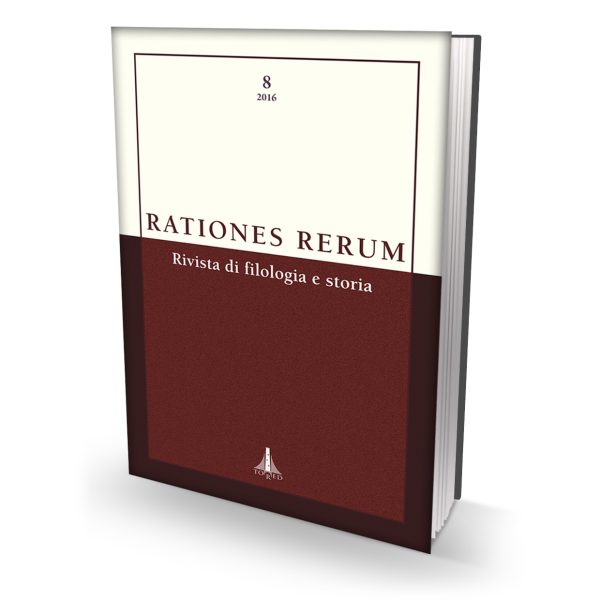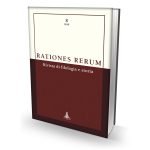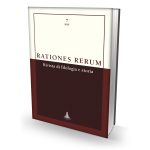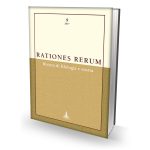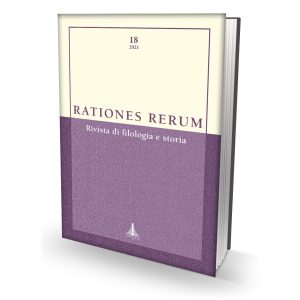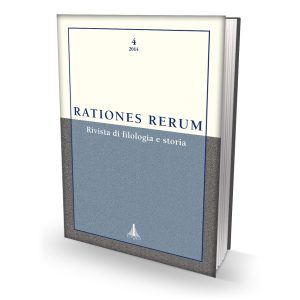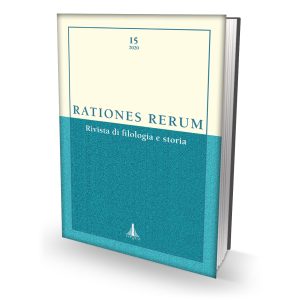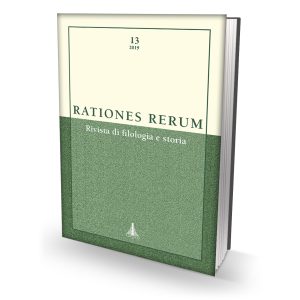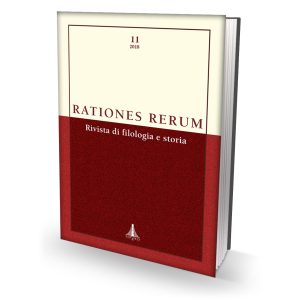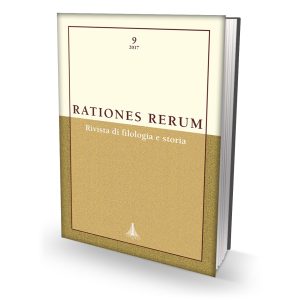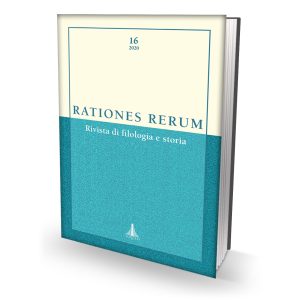RATIONES RERUM 8 – Rivista di filologia e storia
40,00 €
Autori vari
Anno edizione: 2016
Formato 17×24 – Pagine 208
Confezione a filo refe in brossura
Copertina a 2 colori con bandelle
ISBN 9788899846060 – ISSN 2284-2497
Prezzo: € 40,00
- Descrizione
- ANTEPRIMA
- ABSTRACTS
Descrizione
Descrizione
IN ONORE DI EUGENIO LANZILLOTTA I
Sommario
Leopoldo Gamberale, Virgilio Costa, In onore di Eugenio Lanzillotta, p. 9
Alessandro Brambilla, Élites militari in Beozia: la tradizione sugli ἡνίοχοι καὶ παραβάται, p. 11
Ester Cerbo, “L’augurio di una vita tranquilla nell’imminente vecchiaia”. Osservazioni metrico-testuali ad Eur. Erechth. fr. 369 Kannicht, p. 29
Stefania Adiletta, I frammenti di Demone nella Vita di Teseo plutarchea, p. 45
Alfredo Valvo, L’uomo di stato e il buon governo nel De re publica e nel De officiis, p. 57
Francisco J. González Ponce, El «Mito de Sila» y la posible deuda plutarquea respecto de la literatura periplográfica, p. 69
Tiziana Privitera, Il fiore purpureo di Aiace. Note di lettura ad Auson. Epitaph. 3 Green, p. 87
Fabio Stok, Servio, l’epica e la storia, p. 99
Leopoldo Gamberale, Mendositas codicis me fefellit. Spigolature di filologia patristica, p. 119
Riccardo Scarcia, Dal «piè veloce» al velocipede, p. 143
Recensioni
Virgilio Costa, Rec. di Veronica Bucciantini, Studio su Nearco di Creta, p. 177
Anna Pasqualini, Rec. di Biondo Flavio. Rome in Triumph, I, p. 182
Leopoldo Gamberale, Rec. di Augusto Campana, Scritti, III: Storia, civiltà, erudizione romagnola, p. 194
Libri ricevuti, p. 199
Abstracts, p. 201
Indice analitico (a cura di Carlo Di Giovine), p. 205
Istruzioni per gli autori, p. 207
ANTEPRIMA
ABSTRACTS
Alessandro Brambilla
Élites militari in Beozia: la tradizione sugli ἡνίοχοι καì παραβάται
pp. 11-28
Describing the forces deployed by the Boeotians at delion in 424 BC, diodorus mentions the presence of three hundred picked men (ἐπίλεκτοι) called ἡνίοχοι καì παραβάται, who fought in the front of the entire Boeotian line (προεμάχοντο πάντων). on the contrary, Thucydides – who offers a detailed description of the battle and, specifically, of the composition of the armies involved – does not make any reference to a unit bearing this name and does not mention the involvement of ἐπίλεκτοι. nevertheless, modern scholars often consider these ἡνίοχοι καì παραβάται as a standing elite force of the Boeotian κοινόν, even suggesting that they could be the forerunners, or a 5th-century version, of the Theban Sacred Band. The comparison between the accounts of diodorus and Thucydides shows that this idea relies on weak arguments and should ultimately be rejected.
Ester Cerbo
“L’augurio di una vita tranquilla nell’imminente vecchiaia”. Osservazioni metrico-testuali ad Eur. Erechth. fr. 369 Kannicht
pp. 29-44
The paper analyses the most recent interpretations of metrical construction in Eur. Erechth. fr. 369 Kannicht and suggests a new colometry, partially based on the re-evaluation of the 19th-century editions of the tragedy.
Stefania Adiletta
I frammenti di Demone nella Vita di Teseo plutarchea
pp. 45-55
The paper discusses the presence of the Atthidographic tradition in Plutarch’s Life of Theseus, and in particular of two fragments from demon’s Atthis.
Alfredo Valvo
L’uomo di stato e il buon governo nel De re publica e nel De officiis
pp. 57-67
The paper describes the evolution of Cicero’s concept of the statesman from the treatise De re publica, where he expresses the idea that only a return to dictatorship can save Rome, to the philosophical essay De officiis, an exaltation of liberty, whose defense is a duty for all citizens, even in the absence of a popular mandate.
Francisco J. González Ponce
El «Mito de Sila» y la posible deuda plutarquea respecto de la literatura periplográfica
pp. 69-85
Plutarch, at first, seems to have had no special interest in ancient periploi, since he cites them only once. However, a re-reading of the first part of “Sulla’s myth” (De facie 26 = 940f-942C) recalls some literary topics dating back to Himilco, to the Periplus of Hanno, and perhaps to other periplographers, such as pseudo-Skylax.
Tiziana Privitera
Il fiore purpureo di Aiace. Note di lettura ad Auson. Epitaph. 3 Green
pp. 87-98
The paper examines Ausonius’ epitaph to Aiax (Epitaph. 3 Green) from a rhetorical and stylistic point of view. The poet here makes uses of a very popular topos of late latin literature – the flower that blooms from the hero’s blood.
Fabio Stock
Servio, l’epica e la storia
pp. 99-117
The paper examines the idea of history in Servius’ commentary on Vergil. While in the preface to the Aeneid he accepts the traditional definition of epics as an account of history and myth, in the commentary he adopts a more complex position, according to which Vergil used history allusively, poetically mixing fact and fiction.
Leopoldo Gamberale
Mendositas codicis me fefellit. Spigolature di filologia patristica
pp. 119-142
The essay presents a close examination of some passages from Psalm 118, in which famous latin fathers (viz, Hilarius, Ambrose, Augustine, and Jerome) in their Commentaries refer to variant readings in both Greek and latin texts. Sometimes the variant readings are simply different latin translations of the lXX edition. in some instances, however, we can trace a common source, the Alexandrian scholar origenes; in yet other cases, we can postulate the dependence of one latin exegete on another. So, the total number of variant readings is less than that of the sum of the occurrences presented by latin fathers.
Riccardo Scarcia
Dal «piè veloce» al velocipede: mutazioni eroiche
pp. 143-176
This paper deals with the surprising rise of the bicycle as a common utility vehicle both in europe and the Americas in the late 19th century, paying attention to the fallout from that so-called “craze” found in contemporary fiction and even poetry. It analyses, in particular, the plot of an italian novel for teen-agers filled with several hints based on the classical epic tradition.

